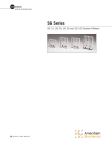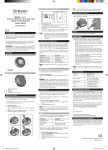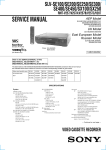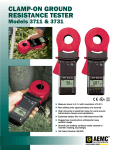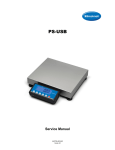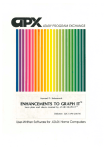Download Hoefer Multiple Gel Casters
Transcript
user manual Hoefer Multiple Gel Casters SE215, SE235, and SE275 um SE215-IM/Rev.L0/08-12 Contents 1. Multiple Gel Caster function................................1 2. Unpacking.........................................................2 3. Assembly...........................................................2 Prepare the gel caster.........................................2 Construct the gel sandwich stack and load into caster..................................................3 Prepare the monomer solution.............................6 Stacking gel preparation.....................................8 Linear gradient gels............................................9 After Gel Polymerization....................................12 4. Care and maintenance......................................13 5. Troubleshooting................................................14 6. Ordering information.........................................16 • pi 1. Multiple Gel Caster function Multiple gel casters prepare gels that are for use in a Hoefer® miniVE, SE250 or SE260 gel electrophoresis unit. The caster model selected depends on the electrophoresis unit used and the number of gels to be prepared: Table 1: Multiple Gel Caster/electrophoresis unit compatibility guide gel plate Gel caster no. of gels size (cm) for use with Hoefer gel electrophoresis unit: SE215 4 –10 10 × 8 SE250 SE235 2– 4 10 × 10.5 SE260, miniVE SE275 2– 4 10 × 8 SE250 Silicone rubber gasket Fig 1. Multiple Gel Caster. The faceplate seals against the cylindrical silicone rubber gasket. Included but not shown: Spring clamps (2 or 4, depending on model) Acrylic casting chamber • Acrylic block • Black vinyl cap for inlet port • Polycarbonate filler sheets • Glass and alumina plates Accessories that may be ordered separately: • Combs • Spacers • Additional plates Filler plugs (1 large, 2 small) Faceplate Inlet port • p1 2. Unpacking Unwrap all packages carefully and compare contents with the packing list, making sure all items arrived. If any part is missing, contact Hoefer, Inc. Inspect all components for damage that may have occurred while the unit was in transit. If any part appears damaged, contact the carrier immediately. Be sure to keep all packing material for damage claims or for repacking should it become necessary to return the unit. 3. Assembly All casters are assembled and used in the manner described below. Both single concentration gel and gradient gel instructions are included. Prepare the gel caster 1 Note: Wear gloves to keep the caster and plates free of finger marks. Prepare gel caster, plates and spacers by washing with a mild detergent and rinsing thoroughly with deionized water. 2 Periodically remove the U-shaped silicone rubber gasket and inspect for nicks. If the gasket appears to be intact, apply a light film of Gel seal lubricant to it and replace: avoid stretching the gasket by laying it onto the groove and pressing it into place. (Gel seal is supplied with the SE250 and SE260 units.) • p2 3 Single-concentration gels — Plug the red inlet port near the bottom of the faceplate with the black vinyl cap included with the unit. Check that the two small semi-circular and one large triangular rubber filler plugs, which reduce the amount of solution needed to fill the chamber, are properly seated in the bottom. The crosswise groove in the plug distributes the monomer solution to all gel sandwiches so that they fill to the same level simultaneously. Gradient gels — Remove the large triangular plug. Check that the two smaller rubber filler plugs are properly seated in the bottom of the chamber. Refer to page 9 for gradient casting instructions. Construct the gel sandwich stack and load into caster 1 Construct each gel sandwich: For each sandwich, choose one notched alumina plate, one rectangular glass plate and two spacers. Use the same size spacers for each sandwich. Fig 2. Location of T-shaped spacers on notched plate. Lay the notched plate on a flat surface, place one spacer along each edge so that it aligns with the notch. Fit a glass plate onto the spacers as shown. The stem of the T-shaped spacers fits between both plates. The top of the T forms the edge of the gel sandwich, (Fig 2). (Alternatively, assemble the sandwich while it is in a standing position.) 2 Pick up each sandwich and align both sides with the spacers and also the bottom on a flat surface, (Fig 3). Fig 3. Align bottom edges of plates and spacers carefully. • p3 3 Build the stack in the caster. (All components fit flush against the bottom and one side.) Place a polycarbonate sheet in the caster so that 2/3 of the sheet lays within the caster and the rest extends out of the top. (This will act as a lever when inserting filler sheets once all sandwiches are in place.) Face plate Polycarbonate sheet Gel sandwich Fig 4. Stack components (Load from bottom up; Fillers are added after sandwiches are in place to adjust stack height) •P olycarbonate sheet. (Acts as lever for adding fillers below the stack. Aids in inserting filler blocks and disassembling the stack.) • Sheet of wax paper (not visible on drawing). Repeat as needed to fill the caster. • Gel sandwich • Face plate • p4 Place a sheet of wax paper onto the polycarbonate sheet. (The wax paper makes it easier to disassemble the stack.) Slide the first sandwich into the caster along one side, notched plate side down and notched side pointing toward the open end of the caster (top when filled). Repeat with all sandwiches, building the stack by layering sheets of wax paper and gel sandwiches, all oriented the same way. Over the final sandwich, lay a sheet of polycarbonate instead of wax paper so that you can observe the liquid level when pouring the gel solution, (Fig 4). Notes: • Inspect glass for nicks. Use only unchipped plates. • Work on a flat surface for best results. • Clean off the acrylamide film from both sides of each polycarbonate sheet. 4 If pouring fewer gels than the capacity of the caster, lift up the polycarbonate sheet at the bottom of the stack and slide in fillers such as the acrylic block, polycarbonate sheets, or extra glass plates until the stack is approximately 1 mm higher than the chamber sides. (Once fillers are in place, slide the polycarbonate sheet in so that it is level with all other stack components.) (The stack must be slightly thicker than the space so that the stack compresses slightly when the faceplate is clamped in place. If the stack is too tall, a glass plate may break or the caster won’t seal properly, but if the stack is too short, the spacers may fall out of alignment or the stack will not stay vertical.) 5 Lay the faceplate on the casting chamber, aligning it so that is flush with all sides. Pick up the assembled unit and check that the gasket compresses slightly. 6 gel caster number of clamps SE215, SE275 2 SE235 4 Secure the stack with either 2 or 4 clamps (see adjacent table). Open the jaws of the spring clamp, then position the longer side jaws on the faceplate. When the clamp is released, the short jaw seats in the groove on the casting chamber side and the long jaw seats in the groove on the faceplate. 2 clamps — position each clamp in the middle of the faceplate. 4 clamps — Slide the top clamp upward to fit against the end of the groove on the front panel. 7 Stand the assembled caster upright and inspect. Check that the gasket forms a tight seal and is not unduly deformed. Check that the stack fits snugly and that the plates and spacers are still aligned; adjust if necessary. • p5 Prepare the monomer solution 1 Prepare enough monomer solution to fill all sandwiches to the level of the notched plate (or lower if a stacking gel or first dimension IPG strip will be added — see step 2). The formula below allows extra solution to fill the space between the sandwich and the chamber. Table 2: Variables for calculating monomer volume area X cm2 extra vol. required (Y ml) SE215 60 11 SE235 80 8 SE275 60 5 gel caster Monomer = area X × spacer × total gel + extra chamber vol (ml) (cm2) thickness (cm) sandwiches vol (Y ml) An example volume calculation for the SE215 for 10 sandwiches, each with a thickness of 1.5 mm follows: From Table 2, the area variable for the SE215 is 60 and the extra volume variable is 11 ml. (60 cm2) (0.15 cm) (10 sandwiches) + 11 ml extra volume required = 101 ml • p6 2 Deaerate the monomer solution and add the initiator and catalyst just prior to pouring the gel. Fill the solution into only one sandwich, allowing the groove in the bottom plug to distribute the solution evenly between all sandwiches. (Pouring into more than one sandwich could introduce air pockets.) Watch the solution level through the faceplate. See below for the appropriate solution level according to the application. No stacking gel Fill with solution to just below the top of the notched plate. If air pockets form, remove them with a pipette or syringe. Introduce a comb (at a slight angle) into each sandwich, taking care not to trap air under the teeth. Stacking gel Fill with solution to 3 cm below the top of the rectangular glass plate. This height allows 1 cm of stacking gel below the wells. Pour the gel and apply an overlay. (See step 3.) After the gel is set, prepare the stacking gel as described below. 2-D electrophoresis Fill with solution to about 1 cm below the top of the rectangular glass plate. This height allows 4 to 5 mm of space for the IPG Strip and an agarose seal). Overlay the separating gel as described in step 3. 3 Note: Avoid repeated and prolonged contact of n-butanol with the acrylic casting chamber to prevent the acrylic from becoming opaque. If casting polyacrylamide gels, overlay each gel with a thin layer of water-saturated n-butanol, water, or diluted gel buffer to prevent gel exposure to oxygen. Apply the same amount to each gel to keep the gel levels the same. Deliver the overlay solution slowly near the spacer at the side of the sandwich. Allow the solution to flow across the surface unaided. 4 Allow the gel to polymerize for a minimum of 1 hour. See page 12 for stack disassembly. • p7 Stacking gel preparation Important! For optimal gel performance, cast stacking gels just prior to use. Add a stacking gel to as many gels as required either individually to each gel after it is transferred to the electrophoresis unit (see instructions with unit), or to the whole stack of gels while it is still in the caster. To pour stacking gels in a multiple gel caster: 1 Rinse off the overlay with distilled water. Invert the casting chamber to drain. 2 Calculate the stacking gel monomer solution volume (ml): measure the distance, in cm, from the top of the resolving gel to the notch in the notched plate. Multiply this distance by the gel width (8 cm), the gel thickness (cm), and the number of gel sandwiches. Add the extra volume required for the caster model used. (Variable Y in Table 2.) 3 Prepare the stacking gel monomer solution, deaerate it, and add catalyst and initiator. Gauge the amount of volume required to fill the sandwich to the notch by adding the stacking gel with a Pasteur pipette to the first sandwich, which is visible through the faceplate. Then add the same amount of monomer solution to each sandwich, working fairly rapidly. 4 Once all stacking gels are poured, insert a comb (at a slight angle to prevent trapping air) into the front sandwich, allowing the comb sides to rest on the spacers. Insert the remaining combs from front to back in the same manner. Allow a minimum of one hour for the gels to polymerize. See page 12 for stack disassembly. • p8 Linear gradient gels Gradient gels are prepared by first pumping the “light” (lower % acrylamide) solutions and then gradually adding a “heavy” (higher % acrylamide) into the caster by way of the inlet port on the faceplate. 1 Follow instructions for preparing the gel caster on page 2. Remove only the triangular rubber plug from the bottom of the casting chamber, leaving the two smaller plugs in place. 2 Follow the instructions for constructing the gel sandwich stack and loading it into the caster on page 3. 3 Fig 5. Gradient maker set-up. Connect the gradient maker to the gel caster. Run a length of clear vinyl tubing through a peristaltic pump and attach one end of the tubing to the gradient maker outlet port and the other end to the casting chamber inlet port on the faceplate. Adjust the pump to run a rate of about 5 ml/min for 4-gel casters and about 10 ml/min for 10-gel casters. Attach tubing to inlet port of the multiple gel caster, run the tubing through a peristaltic pump, and attach to gradient maker. Mixing chamber Multiple gel caster Gradient maker Peristaltic pump Magnetic stirrer • p9 gel caster required volume range (ml) gradient maker size* SE215 55 –100 SG100 SE235 32– 56 SG50 or SG100 SE275 22– 40 SG30 or SG50 *Actual size depends on calculated volume. 4 Prepare solutions Plug solution Note: 15% solid sucrose (w/v) or 25% glycerol (w/v) in the “heavy” solution minimizes mixing and aids gradient layering. Prepare enough plug solution (50% sucrose or 75% glycerol in 1X separating gel buffer) to fill the space below the sandwiches. The SE215 requires about 30 ml and the SE235 or SE275 requires about 15 ml. The plug solution is pumped in after the gradient to displace all of the monomer solution into the sandwich stack. Optional: Add bromophenol blue to help track the plug as it is pumped into the multiple gel caster. Monomer solution Follow the instructions on page 6, step 1 for calculating the total volume of monomer solution needed. Divide the total volume in half and prepare this volume of each of the higher and lower % acrylamide solutions. 5 Pour the “heavy” solution into the reservoir chamber (the chamber furthest from the outlet). Open the stopcock long enough to displace air in the connection between the chambers and then close. Fill the light solution into the mixing chamber and place a stirring bar in this chamber. Place the gradient maker on a magnetic stirrer and begin stirring at a rate that does not introduce bubbles into the solution. • p10 6 Mix the gradient and pump the solution into the caster. While the solution is stirring, begin pumping from the mixing chamber and open the stopcock to the reservoir chamber. As the last of the monomer solution is leaving the mixing chamber, pour the plug solution into the mixing chamber, leaving no opportunity for air pockets to form in the tubing. Watch for the plug solution to approach the bottom of the sandwiches (do not pump plug solution into the bottom of the sandwiches) then turn off the pump and clamp the tubing so that no air enters the gel caster. 7 Note: Avoid repeated and prolonged contact of n-butanol with the acrylic casting chamber to prevent the acrylic from becoming opaque. Overlay each gel with a thin layer of water-saturated n-butanol, water, or diluted gel buffer to prevent gel exposure to oxygen. Apply the same amount to each gel to keep the gel levels the same. Deliver the overlay solution slowly near the spacer at the side of the sandwich. Allow the solution to flow across the surface unaided. Apply the same amount to each gel to keep all gel levels equal. 8 Allow the gels to polymerize for a minimum of one hour. Open the casting chamber over a sink and discard the plug solution. • p11 After Gel Polymerization 1 To remove combs (if necessary): cover each sandwich with several ml 1X electrophoresis buffer, then work each comb out slowly by gently rocking it side to side while pulling it out. Note: Do not store gels in the caster because they will be difficult to remove. Remove the gel stack from the casting chamber. Take care to keep the spacers in place while separating sandwiches: Slip a razor blade between the first two sandwiches and gently pry the top sandwich loose. Remove the wax paper between each sandwich. 2 Rinse each sandwich with distilled water to wash off the overlay and remove any extra gel adhering to the plates, then blot dry. 3 To use gels — Follow instructions accompanying the electrophoresis unit. To store unused gels — Add approx. 5.0 ml of 1X separating gel buffer to the top of each sandwich, seal with plastic wrap, and lay flat in refrigerator set to 4 °C. Or, lay gels flat, submerge in 1X separating buffer, and store refrigerated. Use within 1 week. • p12 4. Care and maintenance Important! Never autoclave any casting kit component. Clean the unit with soap and water after each use and rinse thoroughly with distilled water. Never use abrasive cleansers. Do not expose the unit to solutions or vapors of aromatic or halogenated hydrocarbons, ketones, esters, alcohols (over 30%), or concentrated acids or bases (over 25%). All components are resistant to common electrophoresis buffers. Clean glass plates with a mild laboratory detergent such as Pierce RBS-35®. • p13 5. Troubleshooting problem solution Plates brokenStack may be too tall. Before clamping, check that the stack is about 1 mm higher than the top of the caster edge. Check that all spacers and plates are aligned before applying the clamps. Notched plate ears brokenAvoid stressing the ears by only handling the sandwiches by the sides and bottom. Separate sandwiches along the bottom of the stack. Caster leaks Apply a light film of Gel seal to the gasket each time the unit is used. Check the foam gasket for cracks or nicks and replace if necessary. If the stack is too tall, the front plate may not seat firmly against the gasket. Remove filler plates until the stack seals. Gel heights uneven Pour the monomer solution into only one sandwich and allow the groove in the triangular plug to evenly distribute the solution. Make sure the groove in the triangular plug is clean and clear of material. Wait one minute before overlaying each gel so that the solution “settles”. Then add the same amount of overlay solution to each sandwich. • p14 problem solution Sample wells damaged or leakRemove air pockets before inserting combs. Slide comb into solution at an angle. If comb must be removed, add more monomer solution before reinserting the comb. Allow the gel to set for a minimum of 1 hour. Remove the comb at a slight angle and very slowly to prevent the gel from becoming damaged. Degas stacking gel solution. Increase catalysts up to 0.1% v/v TEMED, 0.1% v/v APS. Gel sandwiches separatePlace wax paper between sandwiches in the stack and in the back of the caster so that sandwiches separate easily from each other. (This reduces any tendency for plates to stick to each other instead of to the gel.) Also, place a polycarbonate sheet on the top of the stack to prevent a vacuum from forming between the glass and acrylic face plate. Gradient gels — uneven layeringAdd sucrose (15% final concentration) or glycerol (25% final concentration) to the high percent monomer solution. Add a small amount of bromophenol blue to the heavy solution to track the gradient formation. Decrease the pump rate. • p15 6. Ordering information product quantity code number Gel Casters For 10 × 8 cm gels SE275 4-Gel Caster, complete (10 × 8 cm), 2– 4 gels. Includes 4 notched alumina plates, 10 rectangular glass plates, 2 red clamps, 100 sheets wax paper, space-saver plate, 5 filler sheets, set of filler plugs and Spacer-Mate assembly template. (Order combs and spacers separately.) SE275 SE215 Multiple Gel Caster, complete (10 × 8 cm), up to 10 gels. Includes 10 notched alumina plates, 20 rectangular glass plates, 2 red clamps, 100 sheets wax paper, space-saver plate, 5 filler sheets, set of filler plugs and Spacer-Mate assembly template. (Order combs and spacers separately.) For 10 × 10.5 cm gels SE215 SE235 4-Gel Caster, complete (10 × 10.5 cm), 2– 4 gels. Includes 4 notched alumina plates, 5 rectangular glass plates, 4 red clamps, 100 sheets wax paper, space-saver plate, 5 filler sheets, set of filler plugs and Spacer-Mate assembly template. (Order combs and spacers separately.) SE235 Wax paper, precut sheets, for SE275 and SE215 100/pk SE201 Wax paper, precut sheets, for SE235 100/pk SE231 3/pk SE209 Accessories and replacement parts Silicone rubber filler plug set for SE215 Filler plug set for SE235 and SE275 SE279 Filler sheets, for SE275 and SE215 5/pk SE213 Filler sheets, for SE235 5/pk SE233 Space-saver plate, for SE215 and SE275 1 SE217 Space-saver plate, for SE235 1 SE237 • p16 product quantity code number Clamps Red clamps with springs, for use on SE250, SE260 and on gel casters. 4/pk SE252 Spacers thickness (mm) width (cm) quantity For SE250 0.75 8 2 SE2119T-2-.75 1.00 8 2 SE2119T-2-1.0 1.50 8 2 SE2119T-2-1.5 For SE260 and miniVE 0.75 10.5 2 SE2619T-2-.75 1.00 10.5 2 SE2619T-2-1.0 1.50 10.5 2 SE2619T-2-1.5 code number Glass and alumina plates For SE250 (10 × 8 cm) Notched glass plates 5/pk SE202GN-5 Notched alumina plates 10/pk SE202N-10 Rectangular glass plates For SE260 and miniVE (10 × 10.5 cm) 10/pk SE202P-10 Notched glass plates 5/pk SE262GN-5 Notched alumina plates 5/pk SE262N-5 Rectangular glass plates 5/pk SE262P-5 • p17 Combs no. of wells thickness (mm) width (mm) quantity code number 5 0.75 13.0 1 SE211A-5-.75 5 1.00 13.0 1 SE211A-5-1.0 5 1.50 13.0 1 SE211A-5-1.5 *9* 1.00 5.8 1 SE211A-9-1.0 10 0.75 4.8 1 SE211A-10-.75 10 1.00 4.8 1 SE211A-10-1.0 10 1.50 4.8 1 SE211A-10-1.5 12 1.00 4.75 1 SE211A-12-1.0 15 0.75 2.9 1 SE211A-15-.75 15 1.00 2.9 1 SE211A-15-1.0 15 1.50 2.9 1 SE211A-15-1.5 18* 1.00 2.9 1 SE211A-18-1.0 1/1† 0.75 68/5 1 SE211A-R-.75 1/1† 1.00 68/5 1 SE211A-R-1.0 1/1† 1.50 68/5 1 SE211A-R-1.5 *Microtiter spacing † Preparative/reference well Gradient makers volume (ml) chamber ID (cm) quantity SG15 15 1.27 1 SG15 SG30 30 1.58 1 SG30 SG50 50 1.91 1 SG50 100 2.54 1 SG100 SG100 • p18 code number Hoefer, Inc. 84 October Hill Road Holliston, MA 01746 Toll Free: 1-800-227-4750 Phone: 1-508-893-8999 Fax: 1-508-893-0176 E-mail: [email protected] Web: www.hoeferinc.com Hoefer is a registered trademark of Hoefer, Inc. RBS-35 is a trademark of Pierce Chemical Co. © 2012 Hoefer, Inc. — All rights reserved. Printed in the USA.
























